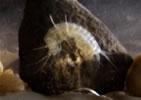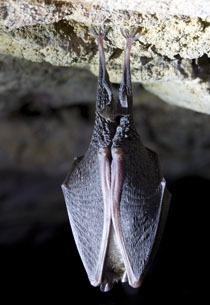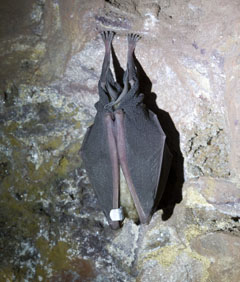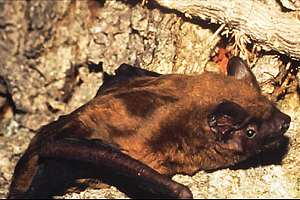 |
Cave Life of Wales |
 |
| |
| HOME |
| INTRODUCTION |
| LIFE IN THE ENTRANCE |
| LIFE IN THE CAVE |
| CONSERVATION |
| GLOSSARY |
| ACKNOWLEDGEMENTS |
| |
| Bacteria |
| Fungi |
| Plants, Algae & Protozoans |
| Sponges |
| Flatworms |
| Eelworms & Segmented Worms |
| Slugs & Snails |
| Crustacea |
| Insects |
| Spiders & millipedes |
| Fish & Amphibians |
| Birds |
| Bats |
Life in the cave - Bats |
||||||
Bats are the only other mammal many people will see in a cave. During summer bats move around and have a selection of roosting sites, often old trees, buildings etc. They may use caves to roost during this time and the females may use them as a nursery for the young. If food is scarce they sometimes go into torpor (controlled lowering of body temperature) much like a hibernating bat. An active bat will have a temperature of about 39 degrees and a heart beat of 1000 per minute. Bats live up to 15 years, they generally eat large insects. They use caves mostly for hibernation and as most species wriggle into small crevices out of sight there may be many more than we realise. HIBERNATING BATS Bats spend more time in torpor as food becomes scarce. They traditionally hibernate from October to late April as their food source (insects) disappears, but with warmer winters more insects are around and the hibernation period is becoming more irregular. All insects fly when the temperature is above 14C but as it drops there are progressively fewer insects on the wing. In late autumn the bats put on weight (not by eating more but by spending more time in torpor) so that their fat reserves will last them for up to five months of hibernation. Once a suitable hibernation site has been found (the air flow, humidity and temperature must be fairly constant – cooler than their summer roosting sites) they crawl into a crevice (only some species hang upside down). In caves they may be far underground where temperature varies little, but in a position where they are able to sense subtle changes in air temperature signifying changes outside. They use echolocation to fly through the undergound passages and select a suitable roost, although they have good eyesight there is absolutely no light in the dark zone. Heavy bats prefer warm roosts, skinny bats cooler roosts. Old wise bats regulate their temperature within a narrower band than youngsters and seem to roost singly. In hibernation a bat may breathe once an hour, have a temperature as low as 2C, and a pulse of 10 per minute. Reducing its temperature means it uses less energy. They have a long mating season which extends into winter but are able to store sperm until fertilisation occurs in the spring ( Lesser Horseshoes mating in Old Box Mine, Forest of Dean). By November they may only wake when it is warmer and they can feed. Each day throughout hibernation the bats pulse rate slowly rises until it seems to make an unconscious decision (in mid afternoon) either to carry on raising its pulse and wake up, or allow it to drop again and return to hibernation. Every 10-15 days throughout winter they will wake to feed, urinate, just shuffle their feet, drink or fly off to roost somewhere else (up to 30 miles away). As winter moves by the bats fat reserves dwindle and they choose progressively colder roosts. In November they may go for a 12C roost, by March they prefer a 6C roost. In April they spend less time asleep and choose cool roosts close to feeding grounds, after digestion the bat allows its temperature to drop quickly. If they are disturbed, they slowly wake up – 30 minutes after disturbance the heart rate will have gone from about 20 to 600 beats per minute and the body temperature from about 10C to 36C. This must use a surprising amount of energy, energy the bat cannot afford to use up unnecessarily as the valuable fat reserves are depleted with little hope of replenishment. Too many disturbances will mean that the fat reserves will not last the winter and they literally starve to death. In a state of hibernation bats are so torpid that they appear dead, but it takes very little to disturb them. Bats are quite specific on what temperature they want to hibernate at. Heat from cavers bodies will cause a rise in temperature which is detected by the bat. In a large or draughty passage this effect will be negligible, but in a small chamber or with a group of cavers the effect may be enough to rouse the bat. Heat generated by a caver is probably the most common cause of bat disturbance underground. Shining bright lights on the bat and the noise of a flashgun may be sufficient to wake it up, an increasing problem as cavers continually build brighter lights. Try not too shine your light directly on the bat. Many, like the Greater Horseshoe, are particularly vulnerable if there is a prolonged cold spell at the end of winter when their energy supplies are at their lowest. In spite of disturbance by groups bats do use Porth yr Ogof, in the winter of 2010/11 a bat spent 6 weeks in a passage that was used by hundreds of people.
The HORSESHOE BATS have a cone shaped nose leaf and hang by their hind feet with their wings wrapped around themselves. The most common bat you may see in Welsh caves is the Lesser Horseshoe bat (Rhinolophus hipposideros). Wales has 10,000 of the 17,000 British population and the population trend shows a steady increase over the last 10 years having suffered a decline in the previous 100. It is 15-19mm in length and weighs just 5-9 gram, making it one of our smallest bats. In winter they typically roost in the cave in open or exposed positions, and segregated as opposed to in clusters. They prefer cooler sites than the Greater Horseshoe and are predominantly found in South Wales, Forest of Dean, Pembroke and Gwynedd (which is its northern limit). They are small, very agile and can be found further underground than other species in e.g. Agen Allwedd, Siambri Ddu, Eglwys Faen and occasionally in Ogof Clogwyn. In Agen Allwedd the preferred hibernation sites are over 200m from the entrance where the temperatures are higher and relatively stable compared to those found outside. Siambri Ddu has a short entrance passage leading to a single chamber and so the temperature is likely to fluctuate during the winter. The peak numbers in Siambri Ddu appear to be early in the winter and the bats then seek sites further underground such as Agen Allwedd where the peak numbers are in January. These bats may be found low down on boulders near your feet as well as hanging on the walls and ceiling. They do not hibernate as deeply as the Greater Horseshoe and are more likely to venture outside in winter to forage. In winter they feed on crane flies, dung flies and fungus gnats. In summer they emerge from their roost 30 minutes after sunset to feed in sheltered deciduous woodland.
The Greater horseshoe bat (Rhinolophus ferrum-equinum) prefers warm roosts and hibernates in caves and mines of south Wales with the largest populations in the limestone cliffs of south Pembrokeshire and the caves and mines of the lower Wye valley and Forest of Dean. Unlike the Lesser Horsehoes these bats may cluster together in groups of up to 350 for warmth. Their summer nursery roosts include a few caves where they congregate, tightly packed, in high domed chambers to raise the temperature to 30C, but this is increasingly rare in Britain. In autumn, as the nursery breaks up, the adults seek out cooler areas while the young may stay until October. Males may roost underground in summer. Greater Horseshoe bats are at the north western limit of their range is south Wales, although a few individuals have been found in north Wales. It is occasionally found in Eglwys Faen, Ogof Draenen, Gower caves and the mines of the Forest of Dean. It prefers temperatures of 5-11C and it is quite common for it to wake and feed (preferring dung beetles) on warmer winter evenings (above 10C). There are an estimated 350 in Wales out of a British population of 4000. Its numbers have declined massively and it could be vulnerable to extinction in Britain, although the recent warmer climate appears to be helping it spread north and east.
The Evening or VESPER BATS are a family that includes Pipestrelles, these have a muzzle similar to a dog and prefer to hang against a surface like a wall or tree. These bats fold their wings alongside their bodies. If you see a small bat flying outside before dark it is probably a Pipestrelle. Pipestrelles are Britains most common bat but are rarely found in caves. Barbestrelle (Barbestrella barbastellus) - rarely seen, absent from north Wales, it uses caves for hibernation. It was seen in Eglwys Faen in 2011 during an exceptionally cold spell. Brown long eared bats (Plecotus auritus) hunt in dense vegetation. This bat and the Barbestrelle prefer cold places to hibernate (-3 to 11C). This means they are more likely to be found hibernating near the entrances to caves in places like the draughty Eastern Series in Eglwys Faen. They hibernate singly or in small groups from November until late March but may arouse when the temperature is above 4C to catch non-flying prey. Wales has a population of 20 000. They fold their ears back alongside their bodies leaving the tragus (an ear lobe inside the ear), projecting out. Noctule (Nyctalus noctula) - Britains largest bat, about 5000 in Wales. If you see a large bat flying in the open out before dark it is probably a Noctule. They roost almost exclusively in tree holes in the UK but occasionally enter caves in autumn.
The Serotine is a large bat whose range includes parts of south Wales and the Forest of Dean. It has been recorded as hibernating in caves and mines but most likely prefers old buildings. MYOTIS BATS prefer 2-5C. They may be seen swarming round cave entrances in autumn. Many Myotis bats hibernate in crevices including wriggling into loose scree/boulders – so a bat motionless by your feet might be hibernating, not dead! Because Myotis bats hibernate in crevices and are difficult to spot they are probably widely under recorded from British caves in contrast to the Horsehoe bats that hang out in the open. Natterer's bats (Myotis nattereri) hibernate almost exclusively in caves and mines, usually squeezed in a crack or crevice. They hunt in dense vegetation. There are 12,500 in Wales. Daubenton's bat (Myotis daubentoni) (15.000 Wales) - hibernate in caves, mines, tunnels in crevices as well as on open walls. They hunt low over open water are so are found near such habitats. Daubenton's are found in Ogof Draenen, the River Usk below here is an important feeding ground for them. They have a uniform dorsal fur, and large feet to help them glean prey from the water surface. Whiskered bats (Myotis mystacinus)(8,000 Wales) hibernate singly in caves on open walls and in crevices, usually in cool places near the entrances and possibly in more humid situations than Brandt's bats. Like Brandt's bats they have shaggy dorsal fur. The males hibernate until March. Brandt's bat (Myotis brandti), (7,000 Wales) appears to have similar habits to the Whiskered bat. Although these two species are genetically different they share variable characteristics to the extent that there is no one external feature that can be used to differentiate with 100% certainty between the species. They have shaggy dorsal fur and are usually squashed into crevices when hibernating in caves. The males hibernate until May. The Alcathoe bat has recently been confirmed as living in the UK. It is very similar to Brandt's and Whiskered and so presumably can be found in caves. Swarming A number of bats swarm around entrances to caves and mines in the autumn, possibly to mate. These include Natterer's, Whiskered, Brandt's and Daubenton's bats. Bats often carry parasites such as ticks, fleas and mites. BATS AND THE LAW It is illegal to intentionally or recklessly disturb a bat while it is occupying a structure or place that it uses for shelter or protection. Under the Habitats Regulations it is an offence to deliberately disturb a bat (this applies anywhere, not just at its roost and can include photography). If more than one bat is involved, the fine is £5,000 per bat. Bat workers acknowledge the important help they get from cavers to know what is going on in the roosts and hibernaculums used by bats that are inaccessible to non-cavers. Cavers can assist bat conservation groups by not disturbing the bats and by reporting their findings. See the Bat Conservation Trust for more information on bats.
OTHER MAMMALS You may see evidence of badgers, foxes, otters, mink or rats using a cave entrance for shelter. Otter spraints are occasionally seen on prominant rocks just inside the entrance to tunnels and caves, including the triangular rock in the entrance to Porth yr Ogof. |


